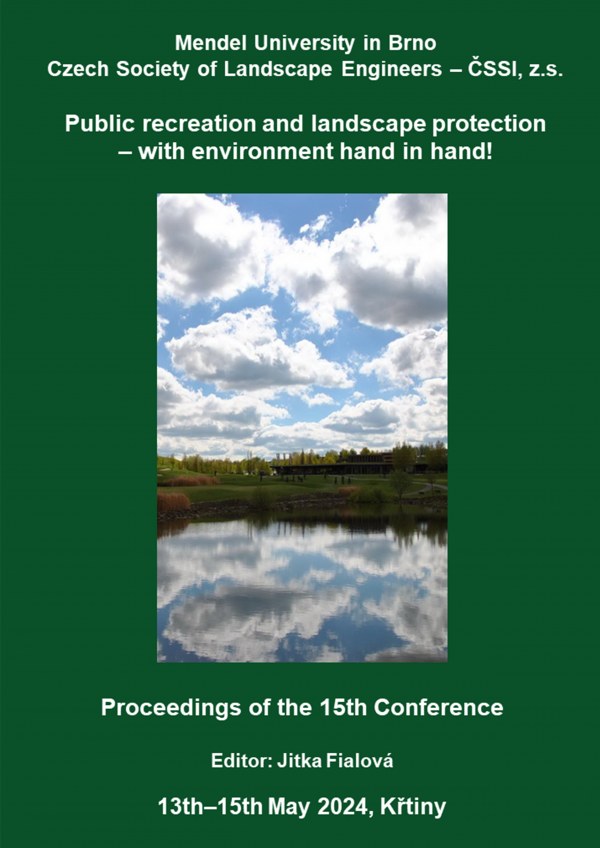
DOI: 10.11118/978-80-7509-963-1-0311
THE “PLACE MEANING” CONCEPT IN EDUCATION: A CASE STUDY FROM THE BOHEMIAN PARADISE PROTECTED LANDSCAPE AREA, CZECHIA
- Dominik Rubáš1,2,4, Anežka Nejedlová4, Tomáš Matějček1,3
- 1 Department of Social Geography and Regional Development, Faculty of Science, Charles University, Albertov 6, 128 00 Praha 2, Czech Republic
- 2 Department of Geography, Faculty of Science, Humanities and Education, Technical University of Liberec, Univerzitní nám. 1410, 461 17 Liberec, Czech Republic
- 3 Department of Geography, Faculty of Science, J. E. Purkyně University in Ústí nad Labem, Pasteurova 3632/15, 400 96 Ústí nad Labem, Czech Republic
- 4 Department of Primary Education, Faculty of Science, Humanities and Education, Technical University of Liberec, Univerzitní nám. 1410, 461 17 Liberec, Czech Republic
The local landscape is a part of the space that surrounds people from childhood and offers them opportunities for cognitive, emotional, and psychomotor development. Students grow up within this landscape, forming a relationship with it, that can extend over large areas throughout their lives. This relationship can be influenced by the meanings that students attribute to the given territory. There is limited research focusing on the concept of “place meaning” in education. The presented study aims to fill this research gap. The respondents are 257 fifth-grade students from primary schools located in the Bohemian Paradise Protected Landscape Area and its immediate vicinity (44% of all fifth-grade students). Data was collected through field research using questionnaires and supplemented by interviews with students in focus groups. Responses were evaluated through content analysis, descriptive statistics, and statistical analysis. The results indicate that, with regard to specific places, students most commonly associate the term Bohemian Paradise with Trosky and Turnov. Additionally, students most commonly recognized these places in photographs. Students most commonly associate the Bohemian Paradise with adjectives such as “beautiful”, “nice”, and “protected”. Boys recognized a greater number of important places in the Bohemian Paradise than girls, and overall, knowledge of these places significantly increases with the time children spend in nature. The results contribute to research on sense of place – an important theme of environmental education.
Keywords: environmental education, children, sense of place, landscape protection
pages: 311-317, Published: 2024, online: 2024
References
- Davenport, M. A., & Anderson, D. H. (2005). Getting from sense of place to place-based management: An interpretive investigation of place meanings and perceptions of landscape change. Society & Natural Resources, 18(7), 625-641. https://doi.org/10.1080/08941920590959613
 Go to original source...
Go to original source... - Foote, K. E., & Azaryahu, M. (2009). Sense of place. In: Kitchin, R., Thrift, N., (eds.). International Encyclopedia of Human Geography. Elsevier, pp. 96-100. https://doi.org/10.1016/B978-008044910-4.00998-6
 Go to original source...
Go to original source... - Harris, F. (2021). Developing a relationship with nature and place: the potential role of forest school. Environmental Education Research, 27(8), 1214-1228. https://doi.org/10.1080/13504622.2021.1896679
 Go to original source...
Go to original source... - Chromý, P., Semian, M., & Kučera, Z. (2014). Regionální vědomí a regionální identita v Česku: případová studie Českého ráje. Geografie, 119(3), 259-277. https://doi.org/10.37040/geografie2014119030259
 Go to original source...
Go to original source... - Kudryavtsev, A., Stedman, R. C., & Krasny, M. E. (2012). Sense of place in environmental education. Environmental education research, 18(2), 229-250. https://doi.org/10.1080/13504622.2011.609615
 Go to original source...
Go to original source... - Lee, H., & Chiang, C.-L. (2016). Sense of place and science achievement in the place-based science curriculum. International Journal of Information and Education Technology, 6, 700-704.
 Go to original source...
Go to original source... - MEYS (2021). Framework Educational Programme for Basic Education. Ministry of Education, Youth and Sports, Czech Republic, Prague.
- Proshansky, H. M., Fabian, A. K., & Kaminoff, R. (1983). Place-identity: Physical world socialization of the self. Journal of Environmental Psychology, 3(1), 57-83. https://doi.org/10.1016/S0272-4944(83)80021-8
 Go to original source...
Go to original source... - Relph, E. (1976). Place and placelessness. London: Pion.
- Semken, S., & Freeman, C. B. (2008). Sense of place in the practice and assessment of place-based science teaching. Science Education, 92(6), 1042-1057. https://doi.org/10.1002/sce.20279
 Go to original source...
Go to original source... - Sobel, D. (2004). Place-based Education: Connecting Classrooms & Communities. The Orion Society.
- Stedman, R. C. (2002). Toward a social psychology of place: Predicting behavior from place-based cognitions, attitude, and identity. Environment and behavior, 34(5), 561-581. https://doi.org/10.1177/0013916502034005001
 Go to original source...
Go to original source... - Stedman, R. C. (2003). Sense of place and forest science: Toward a program of quantitative research. Forest Science, 49(6), 822-829. 10.1093/FORESTSCIENCE/49.6.822
 Go to original source...
Go to original source... - Tomčíková, I., & Rubáš, D. (2023). Vnímanie pojmov miestna krajina a miestny región žiakmi základných škôl. Geografické štúdie, 16, 58-69. https://doi.org/10.24040/2023.9788055720494
 Go to original source...
Go to original source... - UNESCO (2015). SDG4-Education 2030, Incheon Declaration and Framework for Action. For the Implementation of Sustainable Development Goal 4, Ensure Inclusive and Equitable Quality Education and Promote Lifelong Learning Opportunities for All.
- Williams, D. R., & Vaske, J. J. (2003). The measurement of place attachment: Validity and generalizability of a psychometric approach. Forest Science, 49(6), 830-840. 10.1093/FORESTSCIENCE/49.6.830
 Go to original source...
Go to original source... - Young, M. (1999). The social construction of tourist places. Australian Geographer, 30, 373-389. https://doi.org/10.1080/00049189993648
 Go to original source...
Go to original source...


